Scottish household survey 2016: annual report
Results from the 2016 edition of the continuous survey based on a sample of the general population in private residences in Scotland.
8 Physical Activity and Sport
Main Findings
In 2016 the vast majority of adults (79 per cent) had taken part in physical activity and sport in the previous four weeks.
Participation in all physical activity and sport remained relatively constant between 2007 and 2010 (around 72 per cent). Recently people have become more active (rising to 75 per cent in 2011 and again to 79 per cent in 2016). The rise in physical activity is driven by the rise in recreational walking.
Recreational walking (for at least 30 minutes) has consistently been the most common type of physical activity. Participation has risen from 57 per cent in 2011 to 67 per cent in 2016.
Excluding walking, just over half (51 per cent) of the adult population participated in physical activity and sport in the four weeks prior to interview. This has remained broadly constant since 2007.
Frequent participation (on more than 15 days in the past 4 weeks) was undertaken by just under half (48 per cent) of people. This was a slight drop from 50 per cent in 2015 but a pronounced improvement from the 36 per cent of 2007.
Men are more active than women (81 per cent and 77 per cent respectively).
Participation in physical activity and sport including walking declines with age.
Recreational walking is the most common activity. Sixty-nine per cent of women and 66 per cent of men participate.
Sports and exercise participation (including recreational walking) is lower for those living in deprived areas (69 per cent compared to 88 per cent for those living in the least deprived areas).
Health has the biggest impact on participation. Those with a condition causing long term major reduced daily capacity were less likely to be physically active (39 per cent compared to 87 per cent of those with no condition).
Satisfaction with sports and leisure facilities has remained relatively constant since 2011. In 2016 87 per cent of users in the last 12 months were very or fairly satisfied.
8.1 Introduction and Context
Physical inactivity is the fourth leading cause of death globally [56] and contributes to nearly 2,500 deaths in Scotland annually, costing the NHS around £94 million [57] .
The Scottish Government recognises this as a major health challenge and has made increasing physical activity a priority. The percentage of adults meeting the CMOs Guidelines of 150 minutes of moderate of vigorous physical activity a week is one of the 55 national indicators for the National Performance Framework.
More widely we have set out our ambitions for a more active Scotland in the Active Scotland Outcomes Framework [58] ( ASOF), developed in 2014 with partners. The ASOF has six high level outcomes, including getting the inactive active and is underpinned by a commitment to equality. We want to ensure that people of all ages and from all communities across Scotland have the opportunity to participate in physical activity and sport. The ASOF is monitored through 20 indicators, 11 of which use data from the Scottish Household Survey ( SHS).
Questions on physical activity and sport participation were introduced in the SHS for the first time in 2007. The SHS questions cover levels and frequency of participation in physical activity and sport activities in the last 4 weeks. From 2012 onwards, it is possible to obtain data at local authority level every year.
8.2 Participation in Physical Activity and Sport
8.2.1 Participation in Physical Activity and Sport in the Last Four Weeks
- In 2016 approximately four fifths of adults (79 per cent) participated in physical activity.
- The most prevalent activity by far was walking for at least 30 minutes (67 per cent of adults).
The SHS asks "In the last four weeks have you done any of the activities listed". Figure 8.1 shows the full list of activities that respondents could choose from. In 2016 approximately four fifths of adults (79 per cent) participated in physical activity. The most prevalent activity by far was walking for at least 30 minutes (for recreational purposes), reported by 67 per cent of adults. If walking is excluded just over half of adults (51 per cent) participated in physical activity and sport. Participation in activities ranged from two per cent (in bowls) to 16 per cent (swimming).
Figure 8.1: Participation in sports and physical activity in the last four weeks
Percentage of adults (base: 9,640)
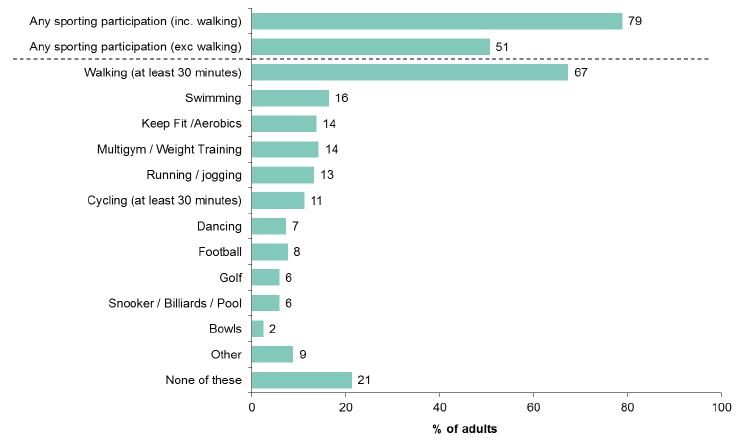
8.2.2 Participation in Physical Activity and Sport – Trends Over Time
- Participation in physical activity is increasing largely due to a rise in walking.
Figure 8.2 and Table 8.1 show that participation in all physical activity and sport remained relatively constant between 2007 and 2010 at around 72 per cent. This was followed by an upward trend from 75 per cent in 2011 to 79 per cent in 2016.
When recreational walking is excluded participation in physical activity and sport has remained relatively constant between 2007 and 2016 fluctuating between 51 and 54 per cent.
Recreational walking on its own shows a similar pattern to all physical activity and sport in that it remained fairly constant between 2007 and 2010 at between 54 and 56 per cent and then showed a steady upward trend from 57 per cent in 2011 to a peak of 69 per cent in 2015. It dropped to 67 per cent in 2016 but the upward trend is maintained. This suggests that the rise in all physical activity is driven by the rise in recreational walking.
Different types of sport also show consistent levels of participation over time with the exception of dancing which has halved in popularity between 2007 and 2016 (14 to 7 per cent).
Figure 8.2: Participation in physical activity and sport in the last four weeks
Percentages, 2007 to 2016 data (minimum base: 9,130)

Table 8.1: Participation in physical activity and sport in the last four weeks
Percentages, 2007 to 2016 data
| Adults | 2007 | 2008 | 2009 | 2010 | 2011 | 2012 | 2013 | 2014 | 2015 | 2016 |
|---|---|---|---|---|---|---|---|---|---|---|
| Any sporting participation (inc. walking) | 73 | 73 | 72 | 72 | 75 | 74 | 78 | 78 | 80 | 79 |
| Any sporting participation (exc walking) | 53 | 52 | 51 | 51 | 54 | 51 | 52 | 51 | 52 | 51 |
| Walking (at least 30 minutes) | 56 | 55 | 54 | 54 | 57 | 59 | 65 | 64 | 69 | 67 |
| Swimming | 19 | 19 | 17 | 17 | 18 | 17 | 17 | 18 | 17 | 16 |
| Keep Fit /Aerobics | 12 | 12 | 12 | 13 | 14 | 14 | 13 | 13 | 14 | 14 |
| Multigym / Weight Training | 11 | 11 | 11 | 11 | 12 | 12 | 12 | 12 | 13 | 14 |
| Running / jogging | 10 | 9 | 10 | 10 | 11 | 11 | 12 | 12 | 12 | 13 |
| Cycling (at least 30 minutes) | 9 | 9 | 9 | 9 | 10 | 10 | 11 | 11 | 12 | 11 |
| Dancing | 14 | 12 | 11 | 10 | 10 | 8 | 7 | 7 | 7 | 7 |
| Football | 9 | 8 | 9 | 9 | 8 | 7 | 8 | 7 | 8 | 8 |
| Golf | 9 | 8 | 8 | 7 | 8 | 6 | 7 | 6 | 6 | 6 |
| Snooker / Billiards / Pool | 9 | 9 | 8 | 7 | 7 | 5 | 6 | 5 | 5 | 6 |
| Bowls | 4 | 4 | 3 | 3 | 3 | 3 | 3 | 3 | 2 | 2 |
| Other | 9 | 10 | 6 | 8 | 10 | 10 | 10 | 9 | 9 | 9 |
| None of these | 27 | 27 | 28 | 28 | 25 | 26 | 22 | 22 | 20 | 21 |
| Base | 10,300 | 9,230 | 9,130 | 9,620 | 9,680 | 9,890 | 9,920 | 9,800 | 9,410 | 9,640 |
8.2.3 Frequency of Participation in Physical Activity and Sport – Trends over Time
- Over time people are becoming more active.
- The likely cause is that those who are already active are becoming more active.
Figure 8.3 shows that frequency of participation in physical activity and sport among participants has increased since 2007. The proportion of the population reporting frequent participation (on more than 14 days in the past 4 weeks) increased from just over a third (36 per cent) in 2007, to just under a half (48 per cent) in 2016. Given the relatively steady levels of participation shown in Figure 8.2 it would appear this increase in frequency of participation is due to individuals who are already active becoming more active .
Figure 8.3: Frequency of participation by adults who took part in physical activity and sport in the previous four weeks
Percentages, 2007 to 2016 data (minimum base: 6,240)

8.2.4 Participation in Physical Activity and Sport by Gender and Age
- Men are more active.
- Walking is the most common activity.
- Women walk more than men.
- Generally physical activity declines with age.
- Participation in football, running, jogging and weight training decreases with age.
- Participation in swimming increases with age but tails off after age 45.
- Participation in golf increases with age.
8.2.4.1 By Gender
Physical activity and sport participation is higher for men than women (81 per cent and 77 per cent respectively). This difference was larger when excluding walking (56 and 46 per cent respectively).
As for the population as a whole the most prevalent activity for both men and women was recreational walking. Women participated more than men (69 and 66 per cent respectively).
Men participated more than women in most of the other activities listed apart from dancing (10 and 4 per cent respectively) and keep fit (18 and 9 per cent respectively).
8.2.4.2 By Age
Participation in all physical activity and sport, including walking, declines with age ( Table 8.2). The highest levels of participation were in the 16 to 24 year age group (89 per cent). This fell gradually to 81 per cent for those aged 45 to 59. The decline becomes more evident in the 60 to 74 age group with 72 per cent participation and in the 75+ group only 50 per cent engaged in physical activity.
When walking is excluded, participation also declines markedly with age. Participation is at its highest in age group 16-24 (70 per cent) compared to 37 per cent in those aged 60-74 years and 20 per cent for those over the age of 75.
Walking participation varies between 64 and 74 per cent between the ages of 16 and 74 and declines sharply after this with only 42 per cent of those over 75 participating.
The popularity of different types of sports and physical activity varied by age. Football is one example, with 22 per cent of those aged 16 to 24 having participated in the previous four weeks compared with 4 per cent of 45 to 59 year olds. Running/jogging and weight-training showed a similar pattern. Contrary to this participation in swimming initially increased with age, peaking at around 24 per cent between 25 and 44 years and then began to decline from the age of 45. Golf also shows a pattern of increasing participation with age with the highest level of participation occurring in the 60 to 74 year age group (7 per cent).
Table 8.2: Participation in physical activity and sport in the past four weeks by gender and age
Percentages, 2016 data
| Adults | Male | Female | 16 to 24 | 25 to 34 | 35 to 44 | 45 to 59 | 60 to 74 | 75 plus | All |
|---|---|---|---|---|---|---|---|---|---|
| Walking (at least 30 minutes) | 66 | 69 | 68 | 73 | 74 | 71 | 64 | 42 | 67 |
| Swimming | 15 | 17 | 17 | 24 | 23 | 16 | 11 | 3 | 16 |
| Keep Fit /Aerobics | 9 | 18 | 21 | 18 | 15 | 14 | 9 | 6 | 14 |
| Multigym / Weight Training | 17 | 11 | 27 | 24 | 16 | 11 | 7 | 2 | 14 |
| Running / jogging | 16 | 10 | 29 | 22 | 18 | 9 | 3 | 0 | 13 |
| Cycling (at least 30 minutes) | 15 | 8 | 13 | 14 | 14 | 13 | 6 | 2 | 11 |
| Dancing | 4 | 10 | 11 | 8 | 7 | 8 | 5 | 3 | 7 |
| Football | 14 | 1 | 22 | 13 | 9 | 4 | 0 | 0 | 8 |
| Golf | 10 | 2 | 5 | 5 | 6 | 6 | 7 | 4 | 6 |
| Snooker / Billiards / Pool | 10 | 2 | 15 | 8 | 6 | 5 | 2 | 1 | 6 |
| Bowls | 3 | 2 | 3 | 2 | 0 | 2 | 3 | 4 | 2 |
| Other | 10 | 8 | 14 | 11 | 10 | 8 | 6 | 2 | 9 |
| None of these | 19 | 23 | 11 | 13 | 14 | 19 | 28 | 50 | 21 |
| Any sporting participation (inc. walking) | 81 | 77 | 89 | 87 | 86 | 81 | 72 | 50 | 79 |
| Any sporting participation (exc walking) | 56 | 46 | 70 | 63 | 59 | 49 | 37 | 20 | 51 |
| Base | 4,400 | 5,240 | 730 | 1,270 | 1,480 | 2,380 | 2,450 | 1,330 | 9,640 |
Columns add up to more than 100 per cent as multiple responses allowed.
8.2.5 By Age Groups Over Time
- Participation in physical activity and sport remains stable in most age groups.
- Upward trend in recreational walking seen from 2011 applies to all age groups.
Figure 8.4, Figure 8.5 and Figure 8.6 show how physical activity and sport participation (including and excluding walking) and recreational walking in the previous four weeks has changed over time within different age groups.
The upward trend in participation in physical activity and sport including walking shows within almost all age groups. The exception is for the 25 to 34 year age group where participation has decreased slightly, going from 91 per cent in 2015 to 87 per cent in 2016 but the upward trend is maintained ( Figure 8.4).
Figure 8.4: Participation in physical activity and sport (including walking) in the last four weeks over time by age
Percentages, 2007 to 2016 data (minimum base: 710)
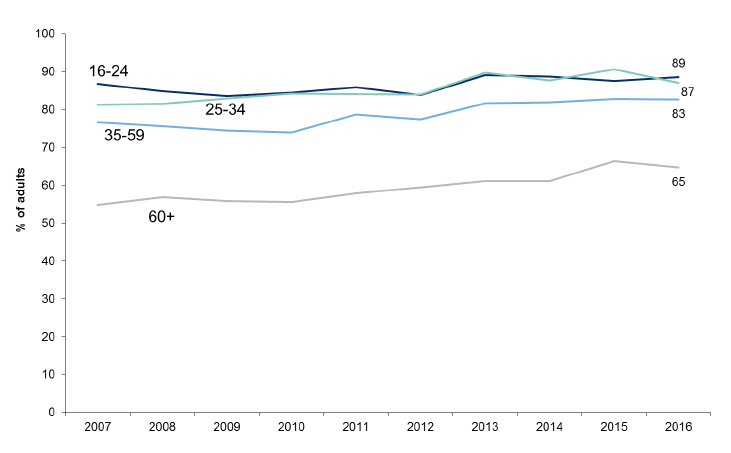
Figure 8.5 shows how physical activity and sport participation (excluding walking) has remained relatively stable within most age groups over time. Similar to the pattern when walking is included, the 25 to 34 year age group has seen a decrease in participation going from 70 per cent in 2015 to 63 per cent in 2016.
Figure 8.5: Participation in physical activity and sport (excluding walking) in the last four weeks over time by age
Percentages, 2007 to 2016 data (minimum base: 710)
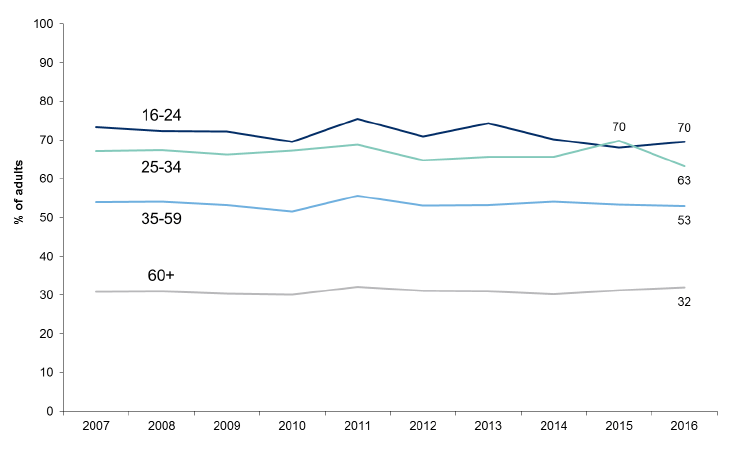
Figure 8.6 shows the upward trend in recreational walking seen from 2011 applies to all age groups. The levels of participation in 2016 have remained consistent with those seen in 2015 except in the 60+ age group where a small decline has occurred (from 59 to 57 per cent), although the upward trend remains.
Figure 8.6: Participation in recreational walking in the last four weeks over time by age
Percentages, 2007 to 2016 data (minimum base: 710)
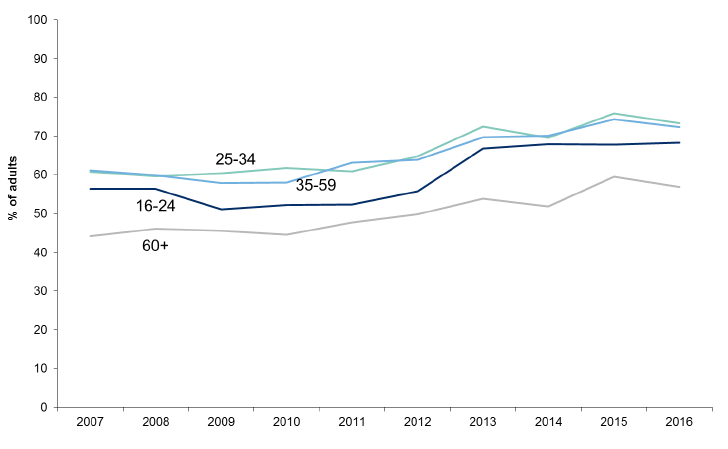
8.2.6 Participation in Physical Activity and Sport by Highest Level of Qualification
- Participation was highest amongst those with a degree or professional qualification and lowest for those with no qualifications
Figure 8.7 shows how participation in physical activity and sport (including walking) varies with level of qualification. In 2016 participation was highest amongst those with a degree or professional qualification (90 per cent) and lowest for those with no qualifications (54 per cent). When walking is excluded, the difference between qualification levels is even greater (66 per cent compared to 23 per cent). Walking is the most prevalent activity across the range of educational attainment but there is still a 32 percentage point gap in participation between those with a degree or professional qualification (81 per cent) and those with no qualification (46 per cent).
Figure 8.7: Participation in physical activity and sport in the past four weeks by highest level of qualification
2016 data, percentage of adults (minimum base: 60)
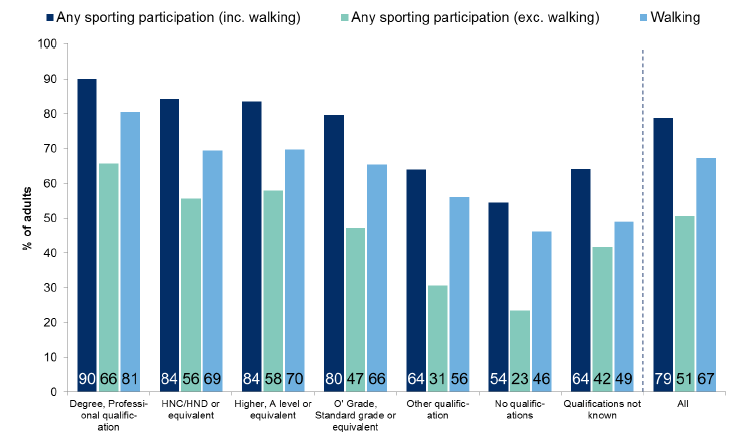
8.2.7 Participation in Physical Activity and Sport by Area Deprivation
- Sports and exercise participation (including recreational walking) is lower for those living in deprived areas and higher in the least deprived areas.
- However, some activities (football, snooker, bowls and dancing) were broadly similar between areas of both high and low deprivation
Figure 8.8 shows how participation in physical activity and sport (including walking) varies by area deprivation. Participation in the previous four weeks was lowest (69 per cent) among those in the 20 per cent most deprived areas of Scotland, compared with 88 per cent in the 20 per cent least deprived areas, as measured by the Scottish Index of Multiple Deprivation ( SIMD). Participation excluding walking and participation in walking follow the same pattern with higher levels being associated with lower levels of deprivation.
Figure 8.8: Participation in physical activity and sport in the last four weeks by Scottish Index of Multiple Deprivation
2016 data, percentage of adults (minimum base: 1,730)
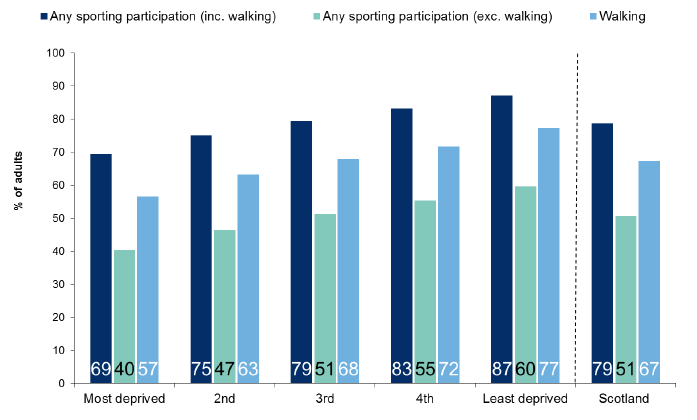
Table 8.3 shows participation in a range of different physical activity and sports by SIMD. This indicates that walking is the most popular activity irrespective of SIMD area; however those in the least deprived areas participate substantially more than those in the areas of highest deprivation.
A similarly unequal pattern of participation was observed for swimming, keep fit, running, cycling and golf, whereas levels of participation in football, snooker, bowls and dancing were broadly similar between areas of both high and low deprivation.
Table 8.3: Participation in different types of physical activity and sport in the last four weeks by Scottish Index of Multiple Deprivation
Percentages, 2016 data
| Adults | Most deprived 20% | 2nd | 3rd | 4th | Least deprived 20% | Scotland |
|---|---|---|---|---|---|---|
| Walking (at least 30 minutes) | 57 | 63 | 68 | 72 | 77 | 67 |
| Swimming | 14 | 15 | 17 | 16 | 19 | 16 |
| Keep Fit /Aerobics | 10 | 12 | 14 | 15 | 17 | 14 |
| Multigym / Weight Training | 11 | 12 | 15 | 15 | 18 | 14 |
| Running / jogging | 8 | 12 | 13 | 15 | 17 | 13 |
| Cycling (at least 30 minutes) | 6 | 9 | 12 | 11 | 17 | 11 |
| Dancing | 6 | 6 | 7 | 8 | 9 | 7 |
| Football | 8 | 8 | 8 | 6 | 7 | 8 |
| Golf | 3 | 5 | 4 | 8 | 9 | 6 |
| Snooker / Billiards / Pool | 6 | 7 | 6 | 6 | 5 | 6 |
| Bowls | 2 | 3 | 3 | 2 | 2 | 2 |
| Other | 4 | 6 | 11 | 12 | 11 | 9 |
| None of these | 31 | 25 | 21 | 17 | 13 | 21 |
| Any sporting participation (inc. walking) | 69 | 75 | 79 | 83 | 87 | 79 |
| Any sporting participation (exc walking) | 40 | 47 | 51 | 55 | 60 | 51 |
| Base (minimum) | 1,880 | 1,990 | 2,070 | 1,970 | 1,730 | 9,640 |
Columns add up to more than 100 per cent as multiple responses allowed.
Figure 8.9 shows that the gap between participation in sport and physical activity in the 20 per cent most deprived areas and the rest of Scotland is consistent over time. For participation in any sport and physical activity (including walking) the gap was 12 percentage points in 2007 (63 per cent and 75 per cent respectively) and the gap remains 12 percentage points in 2016 (69 per cent and 81 per cent respectively). When walking is excluded the gap varies from between 9 and 14 percentage points. For recreational walking the gap narrows over time from 16 percentage points in 2007 to 14 percentage points in 2016.
Figure 8.9: Participation in different types of physical activity and sport in the last four weeks over time by Scottish Index of Multiple Deprivation
2016 data, percentage of adults (minimum base: 9,130)
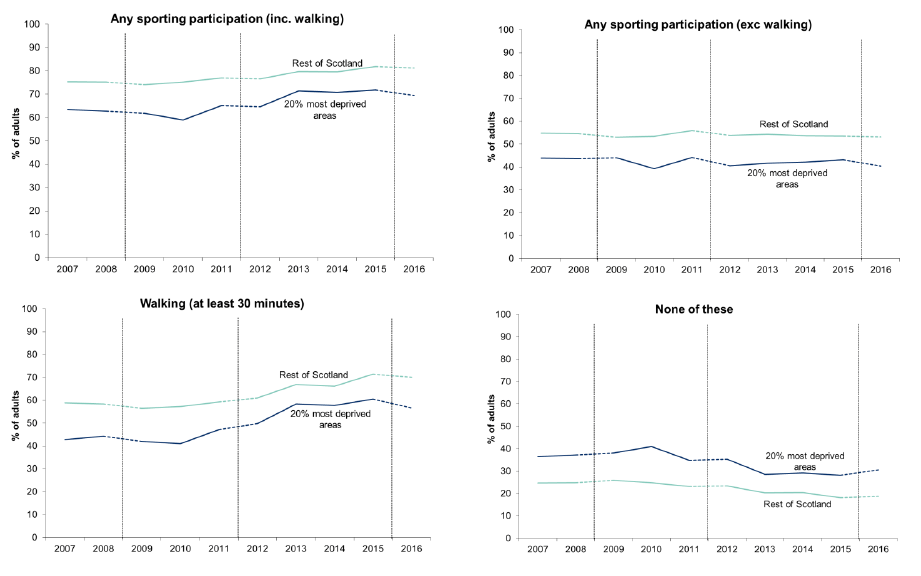
8.2.8 Participation in Physical Activity and Sport by Long-term Physical/Mental Health Condition
- Poor physical or mental health affects physical activity, with higher participation for those who are well.
Figure 8.10 shows participation in physical activity and sport by long-term physical or mental health condition (lasting, or expected to last 12 months or more). Participation was lowest for those who reported a condition which caused long-term major reduced daily capacity (39 per cent), compared to 87 per cent participation for those with no condition. For those where the condition caused minor reduced daily capacity, the participation rate was also lower at 70 per cent.
There is also a marked difference in participation in recreational walking between those with (30 per cent) and without longer-term physical and mental health conditions (74 per cent) and hence sports and physical activity participation whether walking is included or not.
Figure 8.10: Participation in physical activity and sport in the last four weeks, by long-term physical/mental health condition
Percentages, 2016 data (minimum base: 1,290)
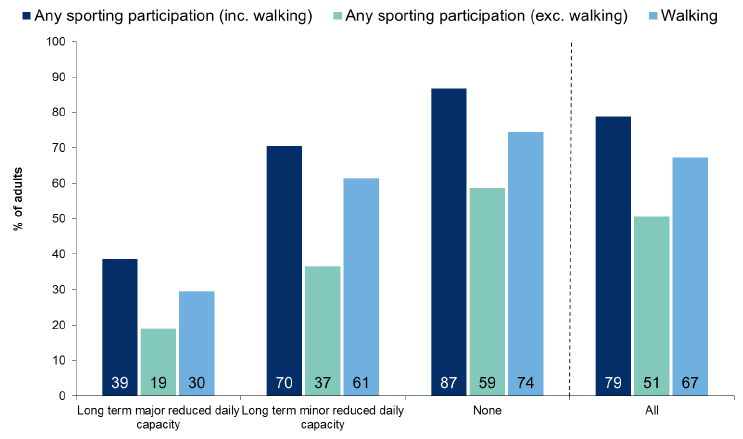
8.3 Satisfaction with Local Authority Cultural and Sports Services
- Most (87 per cent) users were satisfied with local authority sports and leisure services. This has been stable since 2011 but has increased since 2007.
Since 2007, questions have been asked in the Local Services suite of questions in the SHS on the frequency of use and satisfaction with local authority cultural and sport and leisure services. Table 8.4 presents the results for satisfaction with local authority sports and leisure services in 2016. It shows that levels of satisfaction amongst respondents (which include non-users) have been relatively constant since 2007 at around 50 per cent. There has been a small decrease in the proportion who expressed dissatisfaction from around 8 per cent between 2007 and 2011 to around 5 per cent from 2012 to 2016.
Table 8.4: Satisfaction with local authority sport and leisure services
Column percentages, 2007 to 2016 data
| Adults | 2007 | 2008 | 2009 | 2010 | 2011 | 2012 | 2013 | 2014 | 2015 | 2016 |
|---|---|---|---|---|---|---|---|---|---|---|
| Sports and leisure facilities | ||||||||||
| Very/fairly satisfied | 50 | 50 | 48 | 49 | 51 | 51 | 53 | 52 | 51 | 50 |
| Neither satisfied or dissatisfied | 11 | 9 | 9 | 9 | 9 | 7 | 9 | 12 | 14 | 14 |
| Very/fairly dissatisfied | 9 | 8 | 8 | 8 | 8 | 5 | 6 | 5 | 5 | 5 |
| No opinion | 30 | 32 | 35 | 35 | 33 | 36 | 33 | 31 | 30 | 31 |
| Base | 10,220 | 9,240 | 9,710 | 9,020 | 9,660 | 9,890 | 9,920 | 9,800 | 9,410 | 9,640 |
Table 8.5 shows levels of satisfaction with local authority sports and leisure services, as above, but only amongst adults who have used these services in the past year. In 2016, a large majority were very or fairly satisfied (87 per cent). This has been stable since 2011 but represents an increase compared to 2007 (82 per cent).
Table 8.5: Satisfaction with local authority culture and sport and leisure services. (Service users within the past 12 months only)
Column percentages, 2007 to 2016 data
| Adults | 2007 | 2008 | 2009 | 2010 | 2011 | 2012 | 2013 | 2014 | 2015 | 2016 |
|---|---|---|---|---|---|---|---|---|---|---|
| Sports and leisure facilities | ||||||||||
| Very/fairly satisfied | 82 | 83 | 82 | 82 | 85 | 88 | 88 | 87 | 86 | 87 |
| Neither satisfied or dissatisfied | 7 | 6 | 6 | 6 | 5 | 5 | 5 | 5 | 6 | 5 |
| Very/fairly dissatisfied | 10 | 9 | 10 | 9 | 8 | 7 | 6 | 7 | 7 | 7 |
| No opinion | 1 | 1 | 1 | 2 | 2 | 1 | 2 | 1 | 1 | 1 |
| Base | 3,650 | 3,210 | 3,270 | 3,140 | 3,230 | 3,400 | 3,450 | 3,390 | 3,230 | 3,200 |
Conclusion
This chapter has explored physical activity levels in Scotland. It has been shown that the vast majority of adults in Scotland do some physical activity or sport. Walking is the most common activity.
Contact
Email: Emma McCallum, emma.mccallum@gov.scot
Phone: 0300 244 4000 – Central Enquiry Unit
The Scottish Government
St Andrew's House
Regent Road
Edinburgh
EH1 3DG
There is a problem
Thanks for your feedback